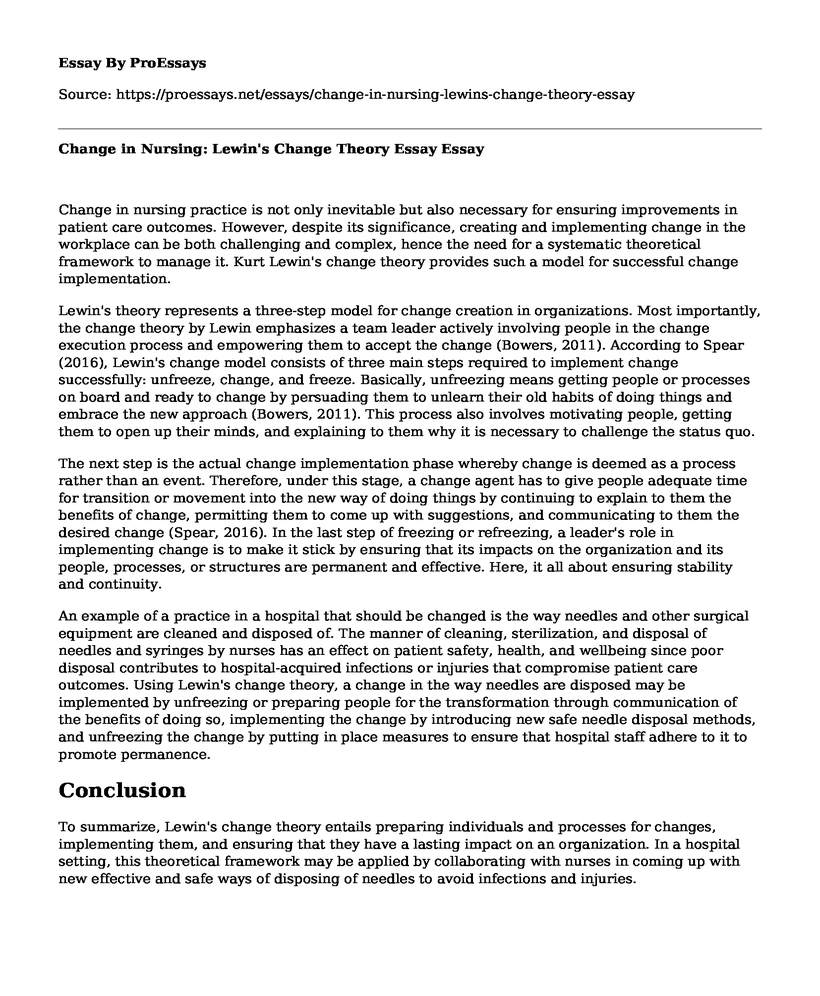Change in nursing practice is not only inevitable but also necessary for ensuring improvements in patient care outcomes. However, despite its significance, creating and implementing change in the workplace can be both challenging and complex, hence the need for a systematic theoretical framework to manage it. Kurt Lewin's change theory provides such a model for successful change implementation.
Lewin's theory represents a three-step model for change creation in organizations. Most importantly, the change theory by Lewin emphasizes a team leader actively involving people in the change execution process and empowering them to accept the change (Bowers, 2011). According to Spear (2016), Lewin's change model consists of three main steps required to implement change successfully: unfreeze, change, and freeze. Basically, unfreezing means getting people or processes on board and ready to change by persuading them to unlearn their old habits of doing things and embrace the new approach (Bowers, 2011). This process also involves motivating people, getting them to open up their minds, and explaining to them why it is necessary to challenge the status quo.
The next step is the actual change implementation phase whereby change is deemed as a process rather than an event. Therefore, under this stage, a change agent has to give people adequate time for transition or movement into the new way of doing things by continuing to explain to them the benefits of change, permitting them to come up with suggestions, and communicating to them the desired change (Spear, 2016). In the last step of freezing or refreezing, a leader's role in implementing change is to make it stick by ensuring that its impacts on the organization and its people, processes, or structures are permanent and effective. Here, it all about ensuring stability and continuity.
An example of a practice in a hospital that should be changed is the way needles and other surgical equipment are cleaned and disposed of. The manner of cleaning, sterilization, and disposal of needles and syringes by nurses has an effect on patient safety, health, and wellbeing since poor disposal contributes to hospital-acquired infections or injuries that compromise patient care outcomes. Using Lewin's change theory, a change in the way needles are disposed may be implemented by unfreezing or preparing people for the transformation through communication of the benefits of doing so, implementing the change by introducing new safe needle disposal methods, and unfreezing the change by putting in place measures to ensure that hospital staff adhere to it to promote permanence.
Conclusion
To summarize, Lewin's change theory entails preparing individuals and processes for changes, implementing them, and ensuring that they have a lasting impact on an organization. In a hospital setting, this theoretical framework may be applied by collaborating with nurses in coming up with new effective and safe ways of disposing of needles to avoid infections and injuries.
References
Bowers, B. (2011). Managing change by empowering staff. Nursing Times, 107(32/33), 19-21.
Spear, M. (2016). How to facilitate change. Plastic Surgical Nursing, 36(2), 58-61.
Cite this page
Change in Nursing: Lewin's Change Theory Essay. (2022, Aug 23). Retrieved from https://proessays.net/essays/change-in-nursing-lewins-change-theory-essay
If you are the original author of this essay and no longer wish to have it published on the ProEssays website, please click below to request its removal:
- Essay Sample on Diagnostic in Nursing
- Case Study of Patient Diagnosed With Alzheimer Paper Example
- Research Paper on Smoking in Houston: Evidence-Based Interventions and Health Risks
- Paper Sample on Analyzing CCHFV: A Review of Roger Hewson's Study
- Developing Good Client Relationships in Social Work - Essay Sample
- Essay Example on Two Dermatologists Spread HBV in Hospital: How HPV Spreads
- Report Example on Achieving Healthcare Transformation: Quality Challenges & Rewards







